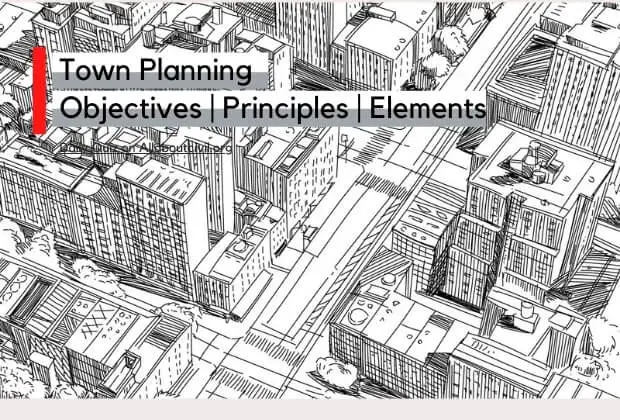Introduction
The term town planning is used to indicate the arrangements of various components or units of a town in such a way that it attains the significance of a living organism.

It also includes ways and means to be adopted for the improvement of existing towns or for the extension of towns, the knowledge of town planning helps in achieving the best possible advantages of the situation of town with respect to its land and the surrounding environments, in a sense, it is proper to say that God made the country and manmade the town.
Town planning is a science as well as art too, the science consists of collecting, correlating, analyzing the facts about the town, the art lies in arranging the components of a town in such a way that the final result is in the form of beautiful, convenient, and economical and efficient units, thus science and art must join their hand and work as co-partners in the difficult task of bringing out a well-arranged town.
Objectives of Town Planning
There are four essential objectives of town planning – Beauty, Convenience, Environment, and Health.
Beauty
The object of beauty is achieved by taking the most possible advantages of natural conditions surrounding the town and also by giving architectural buildings, temples, churches, mosques, buildings of cultural and historical significance, etc.
Convenience
The object of convenience is understood in the form of various economic, social, and recreational amenities to be given to the public, social, these amenities include power and electricity, proper sites for industrial units, transport facility, adequate water supply, easy disposal of sewage and industrial wastes, facilities to commercial units, etc. the recreational amenities include open space, parks, town halls, playground, cinema houses, stadiums, etc.
Environment
The object of the environment is important in the sense that the environment should be molded in such a way that man can go about his normal activities with the least amount of strain. The complex problems of modern society such as tiresome travel to work, long hours of work. limited time spent within the community.
Principles of Town Planning
Following are some of the guiding principles of town planning:
- Green belt
- Housing
- Public buildings
- Recreational centers
- Road transport
- Transport facility
- Zoning
Green belt: The provision of a green belt on the periphery of town results in the limitation of its size hence, the final size of the town is anticipated.
Housing: Extreme care should be taken to provide housing accommodation to various public buildings throughout the town. It should be observed that there is no development of slums and further if slums are existing, they should be cleared.
Public buildings: There should be a well-developed grouping and distribution of various public buildings throughout the town, the unnecessary concentration of public buildings at certain spots of the town should be avoided.
Recreation buildings: Depending upon the size of the town, enough space should be reserved for the development of recreational centers for the general public.
Road system: The efficiency of any town is measured by the layout of its roads, a nicely designed road systems put a great impression in the mind of people especially the visitors of the town, the provision of the faulty road systems in the initial stages of town formation proves to be too difficult and costly to repair or To rearrange in future.
Transport facilities: The town should be provided with suitable transport facilities so that there is minimum loss of time from the place of work to a residence.
Zoning: The town should be divided into suitable zones such as commercial zone, industrial zone, residential zone. etc. and suitable rules and regulations should be formed for the development of each zone.
Selection of Site for an Ideal Town Layout
The important factors to be considered for the selection of a site for an ideal town are:
- Availability of good surrounding, climate conditions, contours of the area, streams, and lakes, fertile land etc.
- Facilities of drainage, sewage disposal.
- Availability of water resources, electric power, means of communication, transport, etc.
- Areas of residence, public, commerce, and industries based on zoning.
- Essential public services like water supply, drainage, electricity, telephone, gas services etc.
- Public amenities like post offices, police stations, petrol pumps, fire brigade stations, dairies, dhobi ghats etc.
- Educational institutions like schools, colleges, etc.
- Recreational amenities like parks, gardens, play grounds, etc.
- Good network of roads.
Elements of Town Planning
Following are the elements of Town planning
1. Built-up area
Built-up areas include:
- Residential building.
- Public and semi-public buildings.
- Commercial buildings.
- Industries.
2. Communications
Communications include:
- Road ways
- Railways
- Airways
- Water ways
3. Good network of roads
These roads run between the built-up areas and connect them with each other.
4. Open spaces
Open spaces include:
- Recreational places like gardens, parks, playgrounds, etc.
- Open lands, other than the above, for graveyards, cremation grounds, burial places, etc.
5. Public utility services
Public utility services include:
- Water supply
- Drainage
- Electricity
- Telephone
- Gas
6. Public amenities
- Post office
- Police station
- Petrol pumps
- Fire brigade station
- Dairies

